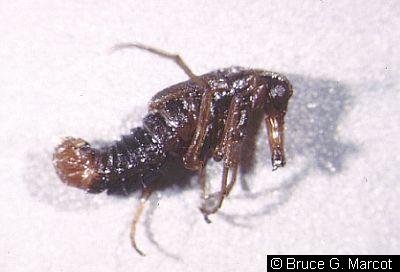Click on the image for a larger version
 |
|
Life on the Ice |
|
|
Click on the image for a larger version
 |
|
Life on the Ice |
|
Snow Scorpionfly (Boreus sp.), Cascade Mountains, Washington |
Credit & Copyright: Dr. Bruce G.
Marcot
| Explanation: What
lives on
ice? We posed this question in a previous
episode of EPOW. Actually, many life forms thrive in extreme
environments, including glaciers and ice fields.
Shown above is one example, a small invertebrate called snow scorpionfly (Boreus sp.) of the family Boreidae, order Mecoptera, captured during my study of old-growth forest patches in the Cascade Mountains of Washington state. Snow scorpionflies -- which are neither scorpions nor flies (nor are they snow, for that matter) -- is an ancient order of insects that are usually found in moss on which they feed, and often on the snow in winter, and are not often collected. The snow scorpionfly has become the symbol of the Entomological Society of British Columbia, Canada, and is the subject of artwork and even stamps. Another denizen of glaciers and ice is the ancient insect grylloblatta. Also called ice bugs, ice crawlers, or rock crawlers, grylloblattas are omnivorous, their diet including frozen insects found on snow and ice. Some entomologists believe that grylloblattas are living remnants of the lineage of insects from which Orthopterans (crickets and grasshoppers) and Dictyopterans (cockroaches and mantids) arose. Another insect of the ice is Chionea, a primitive Dipteran fly related to crane flies. We will explore Chionea in a future EPOW episode. And we have already discussed snowfleas, which are species of springtails that often occur on snow and appear as tiny pink dots. Interestingly, these four examples of life on the ice -- snow scorpionflies, grylloblattas, chioneas, and snowfleas -- are all generally flightless (some snow scorpionflies have wings that are reduced or absent), lacking wings. Are they so primitive that wings never evolved? Or so advanced that they evolved to flightlessness (or remained flightless) in an environment not requiring wide dispersal and movement to find food and shelter, and where dispersal may in fact be hazardous? Much remains to be learned about the evolution and ecology of life on the ice. Acknowledgment: For identification of the specimen in the photo: Dr. Andy Moldenke, Entomologist, Oregon State University |
Next week's picture: Pit Viper Adaptations
Member Theme of Taos-Telecommunity